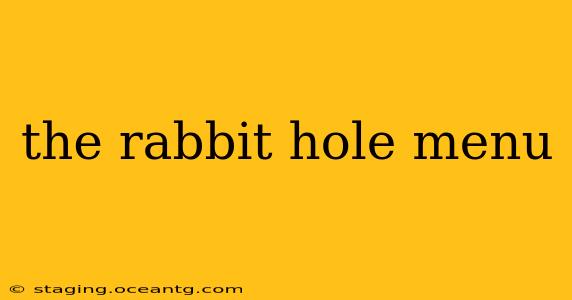The term "rabbit hole menu" isn't a formally recognized design term. However, it evokes a sense of a complex, potentially overwhelming, and deeply nested menu system—one that can lead users down a path of endless clicks, much like Alice falling down the rabbit hole. This article explores the design principles behind complex menus, the pitfalls to avoid, and strategies to create user-friendly navigation experiences, even when dealing with extensive content.
What Makes a Menu Feel Like a "Rabbit Hole"?
A menu feels like a rabbit hole when it's difficult to understand its structure, find the desired option, or predict the outcome of clicking a link. Several factors contribute to this feeling:
- Excessive nesting: Too many levels of submenus make navigation confusing and frustrating. Users quickly lose track of their location and may give up searching.
- Unclear labels: Vague or inconsistent naming conventions create ambiguity, making it hard for users to interpret the meaning and purpose of each menu item.
- Poor visual hierarchy: Lack of visual cues, such as clear headings, spacing, and visual separators, makes the menu appear cluttered and unorganized.
- Inconsistent design: A haphazard layout with varying font sizes, colors, and styles disrupts the user experience and diminishes usability.
- Lack of search functionality: For very large menus, a search bar is crucial to allow users to quickly find specific items.
How to Avoid Creating a "Rabbit Hole" Menu
Designing user-friendly navigation requires careful planning and consideration. Here's how to avoid the pitfalls of a rabbit hole menu:
- Prioritize content hierarchy: Carefully organize your content into logical categories and subcategories. Think about how users are likely to search for information and structure the menu accordingly.
- Use clear and concise labels: Choose descriptive and unambiguous labels that accurately reflect the content behind each menu item.
- Employ a clear visual hierarchy: Use visual cues, such as headings, indentation, and spacing, to guide users through the menu structure. Consider using visual separators or color-coding to group related items.
- Maintain design consistency: Use a consistent style throughout the menu, with consistent font sizes, colors, and styles.
- Implement search functionality: For large menus, a search bar is essential. It allows users to quickly find the information they need without navigating through numerous submenus.
- Consider mega-menus: For extensive content, a mega-menu that displays all subcategories on a single page can improve navigation. However, ensure this remains visually appealing and organized to avoid overwhelming the user.
- Breadcrumbs: Use breadcrumbs to help users track their position within the menu structure. This allows users to easily navigate back to previous levels.
- Progressive disclosure: Reveal only essential options initially and allow users to expand into subcategories as needed. This prevents overwhelming users with excessive information at once.
What are some alternative menu designs?
Beyond hierarchical menus, consider alternative approaches for presenting extensive content:
- Accordion Menus: These menus collapse and expand sections, revealing sub-options only when needed.
- Flyout Menus: These menus appear upon hovering over a menu item, providing a more space-efficient way to display numerous sub-options.
- Tabbed Navigation: This approach organizes content into separate tabs, providing clear visual separation between categories.
How do I test if my menu is user-friendly?
Usability testing is crucial for determining if your menu is effective. Conduct user testing with representative users to observe their navigation patterns and identify areas for improvement. Gather feedback on their experience and analyze the results to refine the menu design.
By following these guidelines, you can avoid creating a "rabbit hole" menu and design a user-friendly navigation experience that enhances user satisfaction and guides users seamlessly to their desired information. Remember, user experience is paramount, and a well-designed menu is a crucial element of a successful website or application.
